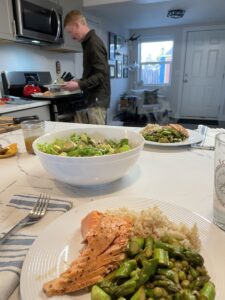
Salmon is delicious and healthy.
On an April morning, we discovered three fish that had spent their lives circling the North Pacific Ocean on our porch in Iowa. Three delicious sockeye salmon landed on our porch. We quickly converted them to delicious meals.
How’s that possible?
Back In Time
The story goes back to 1971 when Rich was a biologist working for the Alaska Department of Fish and Game. “For days the Ugashik River seemed empty of salmon. Then I glanced downstream to see an immense swarm of bright red fish heading my way.” It was the first wave of hundreds of sockeyes that passed by that summer to ascend tributaries to spawn and die.
What Sockeye Salmon Eat
Unlike other salmon species that mostly eat small fish, crabs, and squid, small sockeyes, called smolts, leave freshwater and spend a year, sometimes two years, circling the ocean with their mouths open. They strain zooplankton from the water. Many of these tiny animals are reddish and the color permeates the flesh of Sockeyes, sometimes called Red Salmon.
During his years in Alaska Rich had the chance to eat many fish species, but the Sockeye was his favorite. “They’re delicious, perhaps because they eat low on the food chain. This also keeps them relatively free of contaminants common in other species. I can eat Sockeye without guilt. Thanks to excellent management millions of them swim in the ocean. Biologists make sure that plenty survive fishing nets to ascend rivers to spawn. In recent years Sockeyes have increased,” he said.
Where Get Sockeye Salmon?
Although Sockeye’s are delicious and abundant it’s hard to buy frozen fillets in Iowa.
The Popsie Fish Company solved the problem. The box we found on our porch contained six frozen fillets of Sockeyes caught near Egegik, Alaska.
“We’re beach netters. We stretch gill nets from the beach out into Bristol Bay. Sockeye get tangled in the nets. When the tide goes down, we take the fish from the nets, and fillet and freeze them. Then we ship them everywhere to customers like Rich and Marion Patterson, “said Tony Neal, owner.
These fish are caught and processed right here in the United States.
- Gill netting
- A freshly caught sockeye salmon.
Expensive. It costs about $250 to have ten pounds of fillets sent to our home, but prime beef cuts purchased locally cost about the same, and finding quality fish locally is not easy. All Sockeye salmon sold are wild fish that spent their lives freely swimming in the ocean. That contrasts with today’s beef, pork, chicken, and Atlantic salmon which are crammed together and totally confined.
What is “Atlantic Salmon?”
Any fish marked “Atlantic Salmon” came from a fish factory farm with thousands of fish confined in a huge tank or pen in the ocean. They’re fed a concentrated human-created diet and never have the chance to swim freely in the ocean. They may contain antibiotics.
When in the grocery store look closely at a package of frozen fish that says, “Wild Alaskan” on the label. In fine print it probably says a product of China. Yup, many fish are caught in Alaska, frozen, shipped to China for processing, and refrozen. They are then sent across the ocean and land to the grocery store. Quality suffers.
We love fish and whenever we’re down to the last frozen fillet of Popsie Fish Company’s Sockeye we’ll put in an order for another box to appear on our porch.
A Quick Guide to Salmon
Found in Groceries
Pink Salmon. The most abundant and smallest species of Pacific salmon. Usually the least expensive. Caught in nets.
Coho or Silver Salmon. Normally the latest run of all salmon and available fresh in late summer. Caught in nets and by hook and line. Some are farmed.
King or Chinook Salmon. The largest salmon species and hard to find in the store. Mostly wild caught but some are farmed in New Zealand.
Chum or Dog Salmon. A medium-sized fish usually fairly low-priced and wild-caught.
Sockeye Salmon. The tastiest salmon according to Rich. Always wild and net-capted.
Atlantic Salmon. Not a salmon at all but in a different genus. All Atlantic Salmon on the market are farmed, mostly in Canada, Norway, or Chile.
- Good Catch
- Filleting salmon.
- Processing salmon

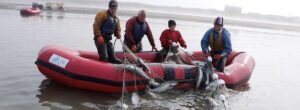
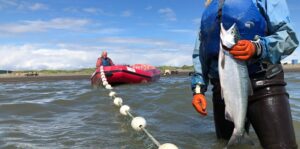
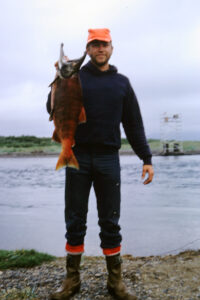
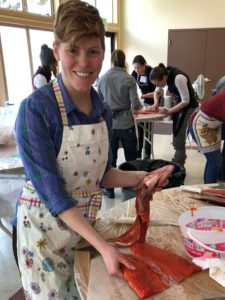
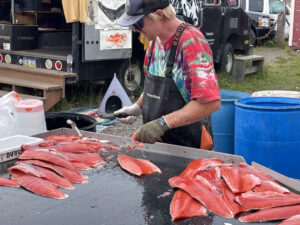

Great fish is available from Sitka Salmon Shares it includes all types of salmon but also halibut rockfish tuna dungagee crab. Shrimp. Look up on website. We eat far more salmon delivered to our door than we would if we had to buy at grocery store. It is always frozen solid
Mary, always good options for people to know about. Thanks. M~